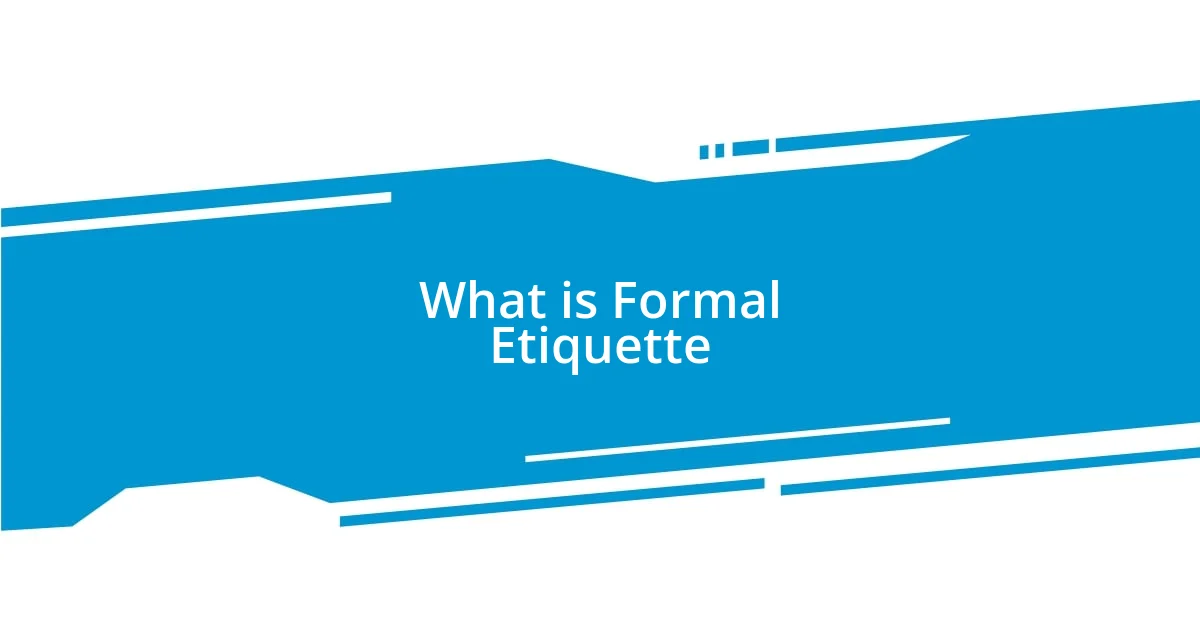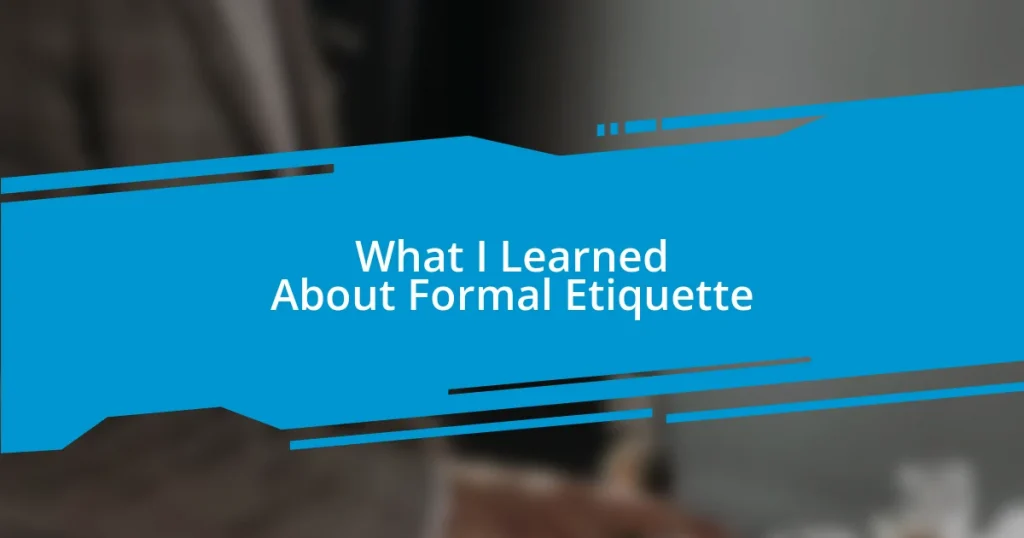Key takeaways:
- Formal etiquette is essential for creating respectful and positive interactions, both socially and professionally.
- Key principles of etiquette include respect for others, awareness of social cues, and consistency in practice to build strong relationships.
- Common mistakes in etiquette, such as poor introductions and bad table manners, can hinder effective communication and networking.

What is Formal Etiquette
Formal etiquette refers to a set of conventional rules that govern social and professional interactions. I remember my first formal dinner; the array of fork placements baffled me! It made me realize how these guidelines help create a respectful and courteous atmosphere.
At its core, formal etiquette is about making others feel valued and comfortable. Have you ever walked into a room and felt the unspoken tension? Understanding and applying etiquette can help defuse that and foster positive connections. I often reflect on how a simple act of polite communication can turn a potentially awkward situation into a pleasant exchange.
The nuances of formal etiquette can vary across cultures and contexts, which adds another layer of complexity. I once attended a cross-cultural event where what seemed polite in my upbringing wasn’t received the same way by others. It taught me that being aware of these subtle distinctions not only enhances my own interactions but also broadens my understanding of the world around me.

Importance of Formal Etiquette
Understanding the importance of formal etiquette is crucial in today’s interconnected world. It not only fosters respect but also enhances our personal and professional relationships. I recall attending a high-stakes business meeting where everyone was dressed impeccably and followed formal introductions. The atmosphere felt warm yet professional; it was evident that our mutual respect was heightened by our adherence to etiquette. When we treat others with courtesy, we pave the way for more effective communication and collaboration.
Here are a few reasons why formal etiquette matters:
- Builds Confidence: Knowing the rules allows you to navigate social situations without anxiety.
- Creates Lasting Impressions: People remember how you make them feel; good etiquette leaves a positive mark.
- Encourages Inclusivity: When everyone follows the same cultural or social norms, it fosters an environment where everyone feels welcome.
- Facilitates Networking: It can open doors to new opportunities and connections that might otherwise remain closed.
- Reflects Personal Brand: Your understanding of etiquette shapes how others perceive you, whether in a job interview or a formal event.
In my experience, these principles not only apply to fancy dinners or corporate environments but also permeate everyday interactions. For example, I remember how a simple ‘thank you’ in a casual setting turned a mundane encounter into a memorable one. That’s the essence of formal etiquette—it enriches our lives in often unexpected ways.

Key Principles of Formal Etiquette
The key principles of formal etiquette revolve around respect, awareness, and consistency. When I think about respect, I recall attending a formal charity gala where everyone was courteous and considerate. It struck me how powerful gestures, like holding a door open or listening attentively, can create an atmosphere of trust and admiration. Respect goes beyond mere politeness; it’s about recognizing the value of others’ feelings and perspectives.
Another important aspect is awareness of social cues and the environment. I once found myself at a wedding where the customs were different from my own. My initial confusion about the rituals was eased when I observed others and adapted accordingly. It taught me that paying attention to those around you not only helps prevent awkward situations but also demonstrates kindness. This adaptability is crucial in formal settings, as it often creates a more inclusive experience for everyone.
Lastly, consistency in etiquette is vital to cultivating strong relationships. I remember a time when I consistently sent thank-you notes after attending events, and the positive feedback I received surprised me. People appreciated the simple act of acknowledgment, reinforcing my belief that formality can be both genuine and genuine connection. By making etiquette a regular practice, we can develop lasting connections and create a reputation built on sincerity and respect.
| Principle | Description |
|---|---|
| Respect | Valuing others’ feelings and perspectives through courteous actions. |
| Awareness | Adapting to social cues and surroundings to foster inclusivity. |
| Consistency | Regularly practicing etiquette to build strong, lasting connections. |

Common Mistakes in Etiquette
One common mistake I often see in formal settings is neglecting the power of introductions. I remember attending a networking event where I spotted a familiar face but hesitated to approach, thinking they’d remember me. Instead, I missed the chance to reconnect. Always take the initiative to introduce yourself; it not only demonstrates confidence but also sets a welcoming tone for the interaction.
Another etiquette pitfall is poor table manners. I once found myself observing a colleague at a business lunch who seemed oblivious to how he handled his utensils. It was a bit distracting and honestly, made the dining experience less enjoyable for everyone involved. Paying attention to basics, like holding your fork correctly or not talking with your mouth full, can make a significant difference in how you’re perceived and how you affect the atmosphere around you.
Lastly, I’ve noticed that discussing controversial topics, particularly in professional settings, can quickly spiral into discomfort. At a dinner party, I overheard someone dive deep into politics, and it created an awkward silence—nothing kills the mood quite like a heated debate. I’ve learned that steering clear of divisive subjects helps ensure that conversations remain pleasant and engaging, fostering a more relaxed environment for everyone involved.

Formal Etiquette in Social Settings
Social settings bring their own unique challenges, especially when it comes to formal etiquette. I still remember attending a high-profile dinner where I felt completely out of my element. The subtle yet distinct way everyone interacted—how they greeted each other with a firm handshake and maintained eye contact—really stood out to me. It made me think: how much do these tiny gestures matter in conveying respect and confidence?
Navigating the conversation is another essential aspect of formal etiquette. At one event, I engaged with a guest who passionately discussed their work, and I realized how important it is to listen actively. I made sure to ask questions and offer encouraging nods. It struck me how this not only helped establish rapport but also made the other person feel valued. Isn’t it amazing what genuine interest can do in making connections feel more meaningful?
I’ve also observed that attire plays a critical role in setting the tone for social interactions. I attended a formal cocktail party where I chose a more relaxed outfit, thinking I’d stand out. Instead, I felt out of place amid the elegant dresses and sharp suits. It reinforced my understanding that dressing appropriately isn’t just about guidelines; it’s about showing respect for the occasion and those around you. After all, don’t we want to fit in without losing our individuality?

Formal Etiquette in Professional Settings
In professional settings, how you carry yourself speaks volumes about your character. I remember attending a formal meeting where attendees not only dressed impeccably but also exhibited a level of composure that was palpable. Their posture, eye contact, and ability to articulate thoughts clearly created an environment of respect and professionalism. It made me reflect on the importance of body language and how much it can influence perceptions in the workplace.
Networking is another cornerstone of proper etiquette in professional environments. I once thought it was enough just to exchange business cards after a brief chat, but that fell flat at a recent industry conference. Engaging in meaningful conversations, asking follow-up questions, and showing genuine interest in others’ work not only helped forge new connections but also left a lasting impression. Have you ever wondered why some people seem to network effortlessly? It’s often because they focus on building relationships, rather than just collecting contacts.
Finally, responding appropriately to invitations and RSVPs is crucial. I had a colleague who often ignored invitations, thinking it wouldn’t matter. However, I learned that acknowledging an invite, whether accepting or declining, shows respect for the organizer’s effort. It really hit home when I hosted a small gathering and a few people didn’t reply—those absences felt much heavier than any last-minute cancellations. It made me realize that this simple act of etiquette enhances not only communication but also the sense of community in professional circles.

Applying Formal Etiquette Daily
Incorporating formal etiquette into my daily life has been a transformative experience. For example, I started making a conscious effort to greet colleagues each morning, and it surprisingly brightened the atmosphere in our office. I saw how even a simple “good morning” could foster a sense of camaraderie—who knew such a small gesture could have such a big impact?
One habit I’ve adopted is carefully crafting my emails. I remember the day I decided to start every email with a friendly salutation and end with a gracious sign-off. It felt more personal and respectful, which I think reflects in the responses I get. Have you ever noticed how your written communication can set the tone for a relationship? I truly believe this subtle shift in etiquette can build better professional rapport over time.
Lastly, I realized it’s essential to show appreciation regularly. I make it a point to express gratitude, whether it’s thanking someone for their input in a meeting or acknowledging their hard work in a project. I can’t stress enough how this practice promotes a positive environment. Don’t you feel uplifted when someone appreciates your efforts? It’s this cycle of respect and acknowledgment that keeps our interactions both pleasant and productive.















